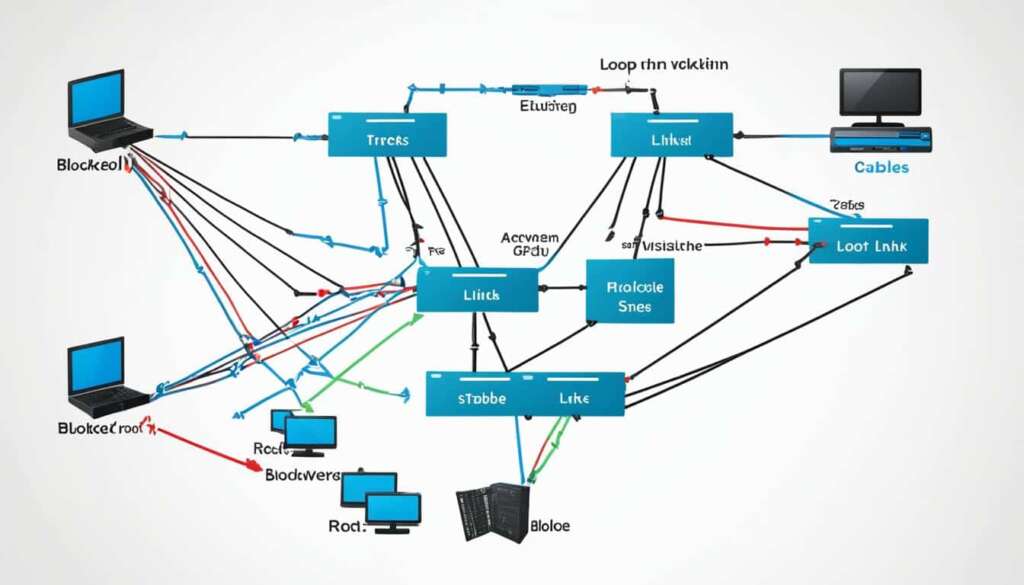Table of Contents
The Spanning Tree Protocol (STP) is an essential Layer 2 network protocol used to prevent looping within a network topology. With STP, you can ensure a loop-free environment while implementing redundancy within your network.
But what exactly is a spanning tree? In the context of computer networks, a spanning tree is a subset of network links that form a connected, acyclic graph, without any loops. By establishing a spanning tree, STP avoids bridge looping and the resulting broadcast storms, leading to improved network performance and stability.
STP achieves this by identifying and disabling redundant links within the network. It follows a set of rules to elect a root bridge, select root ports and designated ports, and set the state of each port. These actions help create a stable and efficient network configuration.
Implementing STP is crucial in building scalable and reliable network infrastructures. It ensures that your network operates smoothly without any unnecessary looping or performance degradation.
How does Spanning Tree Protocol Work?
Spanning Tree Protocol (STP) is a fundamental Layer 2 network protocol that plays a crucial role in preventing loop-related issues within a network topology. By understanding how STP works, network administrators can ensure a stable and efficient network environment.
STP operates by running an algorithm on each bridge that is enabled with STP. This algorithm is specially designed to detect and eliminate bridge loops, which can lead to network disruptions and performance degradation. Bridge loops occur when redundant paths exist in a network, creating multiple routes for packet forwarding and potentially causing endless packet forwarding cycles.
When STP is enabled, bridges actively participate in the protocol by sending and receiving Bridge Protocol Data Units (BPDUs). These BPDUs contain vital network information used to carry out STP operations and maintain a loop-free topology.
The key components of STP operation include:
- Root Bridge Selection: STP elects a root bridge, which serves as the reference point for all other bridges in the network. The root bridge is chosen based on a pre-defined set of criteria, such as bridge priority and MAC address.
- Root Ports and Designated Ports: After the root bridge is determined, each bridge in the network identifies its root port, which is the port that offers the shortest path to the root bridge. Bridges also identify designated ports, which are the ports responsible for forwarding network traffic towards the root bridge.
- Port State: Each port on a bridge is assigned a specific state, which determines its role in frame forwarding. The different port states in STP include:
| Port State | Description |
|---|---|
| Disabled | A disabled port doesn’t participate in STP and doesn’t forward or receive any frames. |
| Blocking | A blocking port is preparing to participate and listen to STP BPDUs but doesn’t forward frames. |
| Listening | A listening port is transitioning from the blocking state to the learning state and doesn’t forward frames. |
| Learning | A learning port starts to populate its MAC address table by examining the incoming frames but still doesn’t forward them. |
| Forwarding | A forwarding port forwards frames and actively participates in STP. |
By setting the appropriate port state for each bridge port, STP prevents any potential loop formations while still maintaining network redundancy. When a loop is detected, STP reacts by blocking or disabling the respective port, thus eliminating the loop and ensuring that frames are forwarded efficiently along the designated path.
Understanding the intricacies of how STP works provides network administrators with the necessary knowledge to troubleshoot network issues related to loop prevention, bridge looping, and port state configurations. By effectively implementing STP, administrators can create a stable and reliable network infrastructure.
Alternatives to Spanning Tree Protocol
While Spanning Tree Protocol is widely used and effective at preventing loops, there are alternative protocols available. One alternative is Transparent Interconnection of Lots of Links (TRILL), which was developed to improve on the spanning tree algorithm. TRILL uses Layer 3 network routing techniques to create a cloud of links that appear as a single IP subnet to IP nodes. This innovative approach allows for efficient communication between nodes while maintaining a loop-free topology.
Another alternative to consider is Shortest Path Bridging (SPB), a protocol that combines the efficiency of Ethernet with the effectiveness of Multiprotocol Label Switching (MPLS). SPB offers backward compatibility with STP while providing improved performance, cost savings, and scalability. By leveraging its ability to determine the shortest path to reach each network destination, SPB ensures a loop-free topology, enabling faster data transmission and increased network capacity.
When compared to traditional spanning tree protocols, both TRILL and SPB offer significant advantages. These alternatives provide faster recovery time in case of network failures, as redundant paths can be dynamically activated when needed. Additionally, the increased efficiency of TRILL and SPB results in improved utilization of network resources, reducing costs and enhancing overall performance.
FAQ
What is Spanning Tree Protocol?
Spanning Tree Protocol (STP) is a Layer 2 network protocol used to prevent looping within a network topology. It identifies and disables redundant links in the network, ensuring a loop-free topology.
How does Spanning Tree Protocol work?
Spanning Tree Protocol works by running an algorithm on each STP-enabled bridge. This algorithm establishes a root bridge, selects root ports and designated ports, and sets the state of each port according to specific rules to prevent loops within the network.
What are the alternatives to Spanning Tree Protocol?
Two alternatives to Spanning Tree Protocol are Transparent Interconnection of Lots of Links (TRILL) and Shortest Path Bridging (SPB). TRILL utilizes Layer 3 network routing techniques to create a cloud of links, while SPB combines Ethernet efficiency with Multiprotocol Label Switching (MPLS) to provide a loop-free topology and improve efficiency.


